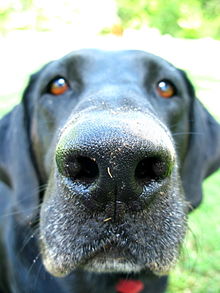Macrosmatic


As macrosmatists or macrosmats (Greek “great nose”) are living beings in which the sense of smell is very well developed and plays a particularly large role within the senses. Living beings with a pronounced sense of smell are characterized by a particularly large portion of the nasal mucosa that is covered with an olfactory epithelium ( olfactory mucosa , olfactory region ).
In mammals , the reception zone of the olfactory system is in the inner nose . In each nasal cavity there are 3 bulge-like structures protruding inward from the outer walls of the nose, the turbinates ( Conchae nasales ), which direct the flow of air. The olfactory area is limited to the olfactory mucosa above the nasal concha. This area is also known as the organum olfactus . This area, which is characterized by a yellow to brown color, contains the sensory cells that specialize in the perception of scent molecules. The area is about 2 × 25 square centimeters in the dog, which is one of the macrosmatists. In the case of humans, who are classified as microsmatic, the area is only about 2 × 5 cm².
Most fish also belong to the macrosmats. The fish nose is not used for breathing, but contains an olfactory epithelium , the surface of which is usually enlarged by lamellae arranged in a rosette. So smelling is also possible in water. The shark's good sense of smell, together with sound waves, allows it to track down its prey.
Microsmatic
Mikrosmatiker or micro Maten , however, have a less developed sense of smell . As a rule, they make more use of visual perception .
literature
- Chapter chemical senses in: Thomas Braun et al .: Short textbook Physiology . 1st edition. Elsevier, Urban and Fischer, Munich 2006, ISBN 3-437-41777-0 .
Individual evidence
- ↑ a b Wolfgang Legrum: Fragrances, between stink and fragrance , Vieweg + Teubner Verlag (2011) p. 43, ISBN 978-3-8348-1245-2 .